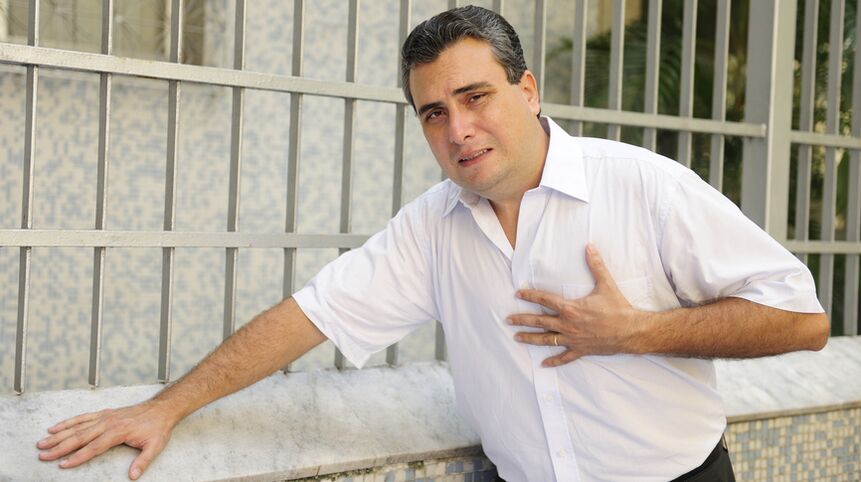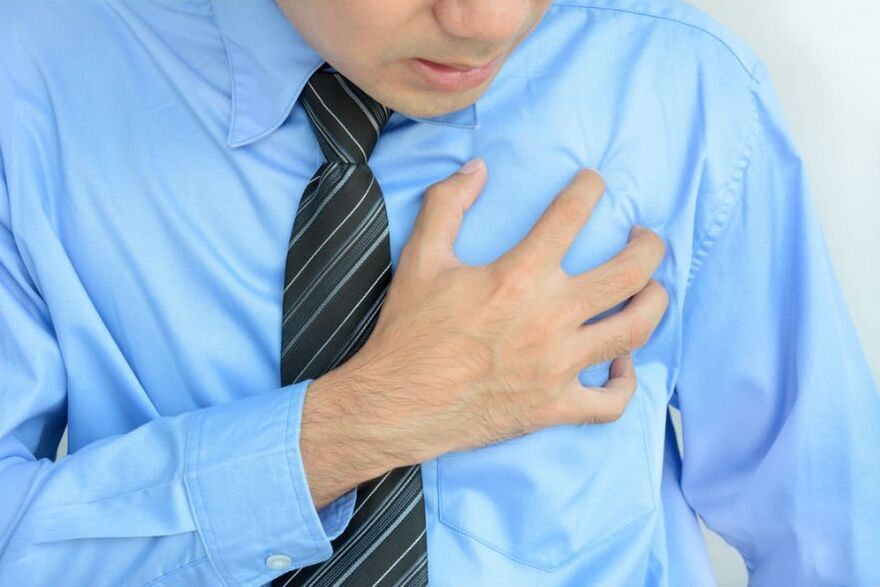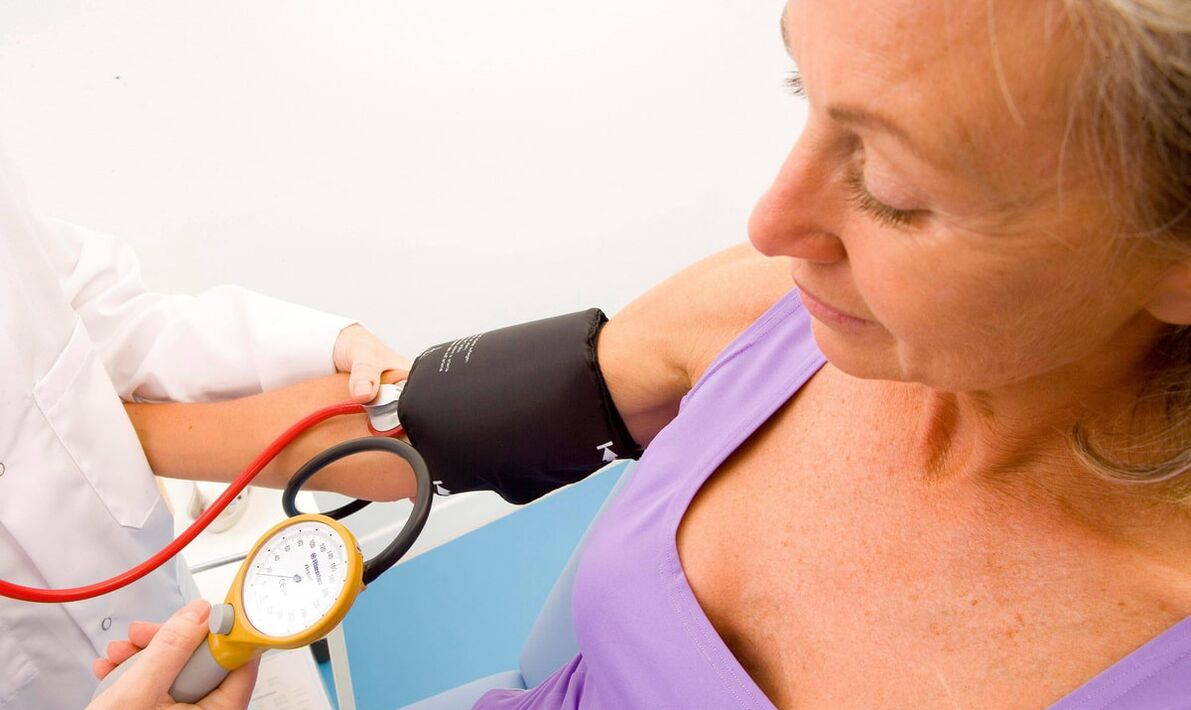
Painful sensations in the heart area force the patient to consult a cardiologist. Anxiety, irritability, and fear for one's own life arise. But not all unpleasant signs are directly related to heart problems. Even thoracic osteochondrosis - symptoms, sensations - pain in the heart causes as often as diseases of this organ.
Pain behind the sternum, closer to the back or even the diaphragm, when the vertebrae are affected, can often occur, regardless of the level of pathology. And the mechanism of unpleasant symptoms has several features.
Mechanism of symptom development
Disorders in the heart during osteochondrosis cannot occur by themselves; it only develops as an echo of the underlying disease:
- Thinning of intervertebral structures. The distance between bone and cartilage elements is reduced, which leads to nerve root blockade. As a result, a painful sensation is formed, which, in the presence of a destructive process in the thoracic or cervical spine, often radiates to the heart.
- Changes in the heart muscle. Due to the disease, the sensation spreads throughout the heart muscle, which is called "echo" of pain.
- Involvement of upper members in the process. The effect of osteochondrosis on the heart may be caused by excessive muscle tension in the arm. As a result, pain is sent to the heart muscle, but the ECG shows no abnormalities.
- Changes in the structure of the lumbar region. The position of the abdominal organs changes, resulting in increased pressure and changes in heart rate.
- Muscle spasms and changes in blood circulation. Pain in the heart with osteochondrosis occurs in response to changes in blood flow in the large back artery. The heart rate increases as blood has to be pumped through narrower passages.
- Severe destruction of the intervertebral disc. The nerve becomes pinched, which leads to pain in the heart area. Hypoxia gradually develops. It also covers brain function, as a result of which the normal function of internal organs changes.
- Caused by arterial compressionand nerve fibers, high pressure may appear. Because of this, painful sensations appear in the heart.
You can distinguish pain in the heart from the manifestation of osteochondrosis by certain symptoms.
Signs of osteochondrosis with painful sensations
Heart syndrome - pain in the heart due to osteochondrosis of the thoracic region - develops in many patients.Symptoms will have the following characteristics:
- pressing, dull pain in heart;
- gradually increasing discomfort, muted, not too obvious;
- pain continues for a long time, covering the chest, causing palpitations;
- there is no sharp intensity of pain due to the destruction of intervertebral cartilage;
- Almost always, symptoms such as a warm feeling behind the sternum help distinguish heart pain from osteochondrosis;
- heart medications (nitrates) do not help relieve pain;
- if a person starts to move their upper limbs, the pain increases.

If the cervical spine is involved in the process, then pain is felt in the vertebral area.
Some patients note that the pain is of a different nature: the discomfort covers the left side of the sternum, affects the muscles, sometimes it spreads to the shoulders, neck and face, and the attacks can last for several days.
If compression of the vertebral artery occurs, additional symptoms appear: weakness, dizziness, spots, and in severe cases the patient loses consciousness. Also, with pain in the heart, there is a decrease in hearing and vision, and blood rushes to the face. If a person takes medication for hypertension, they do not help him.
Differences in pain
There are several ways to distinguish heart pain from osteochondrosis; The main method is to undergo MRI and ECG examination.In addition, you should know what happens with damage to the thoracic cartilage between the vertebrae, and what does not happen with heart disease:
- pain is moderate, increases and persists for a long time. With a heart attack, the symptoms are worse;
- if you press your chin to your chest, the pain of osteochondrosis will increase;
- if the pain increases with movement and exercise, this is osteochondrosis;
- With heart disease, panic, fear, and anxiety always arise.
Neuralgia itself is safe, but can increase when the body is tilted in different directions or when making sharp turns. You can relieve the pain with analgesics.
Serious heart disease and osteochondrosis
You need to know how the liver hurts with osteochondrosis of the thoracic region, especially to distinguish neuralgia from life-threatening conditions. In chronic ischemic heart disease, pain occurs very acutely, within 3-5 minutes. The sensation of a pressing nature does not allow breathing, and after nitrate the symptoms immediately disappear.
If the risk of myocardial infarction is high, then you need to remember that in this situation a person may lose consciousness, experience nausea and acute chest pain. The pain of osteochondrosis has never been so acute.
But with VSD (dystonia), symptoms may be similar. But, unlike pain in the heart with osteochondrosis, with this pathology a person experiences tachycardia, bradycardia, fear, fatigue quickly and feels constant weakness. The pain is usually aching and dull, and with osteochondrosis it is compressive.
pounding
With osteochondrosis, the heart can not only hurt, but also be disturbed by angina pectoris, arrhythmia, and tachycardia. This happens because of the spasm and compression of the arteries.With osteochondrosis, the following features appear:
- increased heart rate at rest, increased rhythm during exercise;
- smooth rhythm without interruption;
- wave-like heat attacks;
- tachycardia may be accompanied by presyncope.
Symptoms disappear if quality disease treatment is carried out.

Extrasystole
Extrasystole is a condition in which there is a sensation of a second heart attack. With osteochondrosis, this complication causes real panic. However, this unusual condition is the norm for the human body. True, most people are not aware of such a process.
Extrasystole is a kind of "stop" in the work of the heart muscle. Surprisingly, short breaks are important for organs.
Such "breaks" happen to people, regardless of their age, weight and daily physical activity.
Stress in osteochondrosis
Among the symptoms of thoracic osteochondrosis is often high blood pressure. But this pathology may have other causes. With osteochondrosis, arteries, veins and blood vessels are compressed, and nutrition of the brain and other organs deteriorates.

The patient began to take medication to solve this problem, as a result of which the blood once again stopped flowing to the brain. Oxygen starvation and nutrient deficiency develop. A person is tormented by symptoms such as: weakness, sleepiness, pain and dizziness, pale skin, nausea.
Dealing with painful sensations
After it is possible to distinguish heart pain from osteochondrosis, the treatment of the disease should be differentiated. If all the symptoms are associated with damage to the thoracic spine, then no medicine can be taken to relieve the pain in the heart.
Therapy should eliminate the cause of osteochondrosis or minimize it. It has been proven that regular and systematic treatment helps relieve tension, spasms, and tension in nerve fibers.Since the heart and osteochondrosis are closely related, treatment should begin with the spine during exacerbations:
- The person cannot move much; bed rest is recommended.
- To relieve acute pain, NSAIDs or glucocorticosteroids are prescribed.
- Local drugs are also used, which are good for relieving pain due to osteochondrosis.
- Physiotherapy helps in the early stages of the disease, but is rarely used to relieve pain. Only during the recovery period after an exacerbation.
- Manual therapy is a very effective method to restore the vertebrae, relieve spasms, tension and swelling of the surrounding tissue.
- Useful exercise and sports therapy for osteochondrosis of the thoracic region is also prescribed.
- In addition, you can use folk recipes - baths and compresses - they are very relaxing and have a positive effect on the patient's emotional state.
- Diet is equally important in the treatment of osteochondrosis. Adequate amounts of plant foods, healthy fats and protein are essential to repair damaged tissue. A balanced diet also helps you lose excess weight.

The best way to determine whether osteochondrosis or the heart is troubling you is to undergo a medical examination. With the help of simple x-rays and ECGs, you can understand the sensations associated with certain diseases.












































